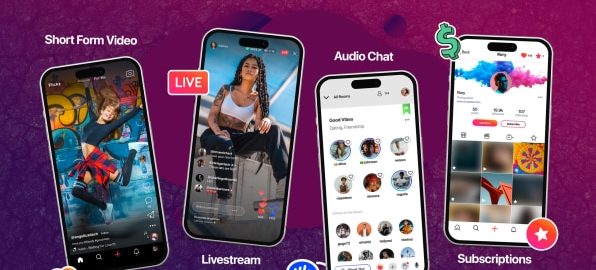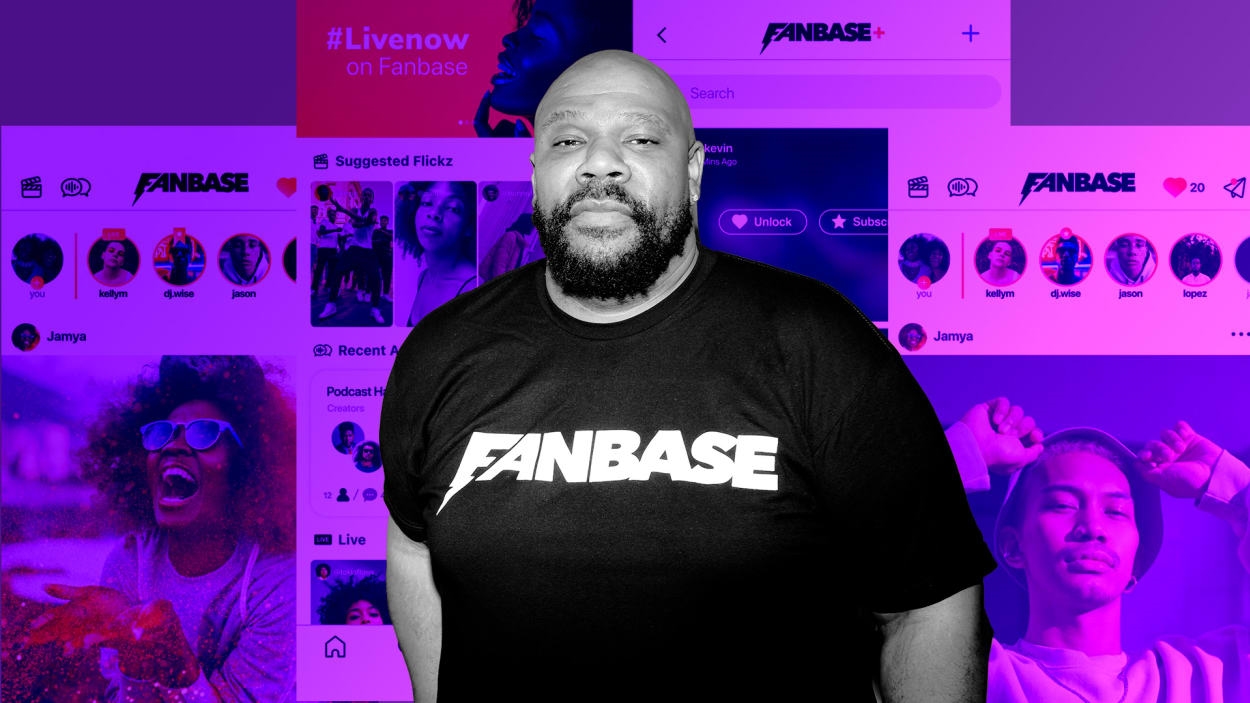By Natasha Ishak
In the online world of social media, where virality is currency—literally, in many instances—Black content creators who start big trends rarely get a payday. Whether it’s starting dance crazes that get coopted by white TikTokkers, who then bag big endorsements, or setting fashion trends online that end up being credited to white celebrities, securing rights to online ideas—and, by extension, the profitability of those ideas—has been a perennial challenge for Black creatives. Music-mogul-turned-techie Isaac Hayes III, founder and CEO of Fanbase, wants to fix that.
“What happens is the little kid that makes the trend that lives in the ‘hood in Atlanta doesn’t wind up getting the brand deal that Charli D’Amelio does,” says Hayes, son of the late music legend Isaac Hayes. “But they’re the inventors of the content.” His solution? Create a platform where creators can profit from their content directly.
Fanbase is a social media app that allows users to monetize various content they produce on the app, which Hayes has built out since he launched it in 2018 to include everything from photos and blog content to long-form videos. This direct-income opportunity is distinct from many other social media apps, where creators must rely on brand partnerships or third-party ad placements in order to make money from their posts.
Social media doesn’t allow much room for viral content to breathe; once a trend gains traction, it spawns scores of copycats overnight, making it difficult to track down the original creator. And even if the creator becomes known, it can be tough to claim a copyright for the sorts of viral short dances that take off online.
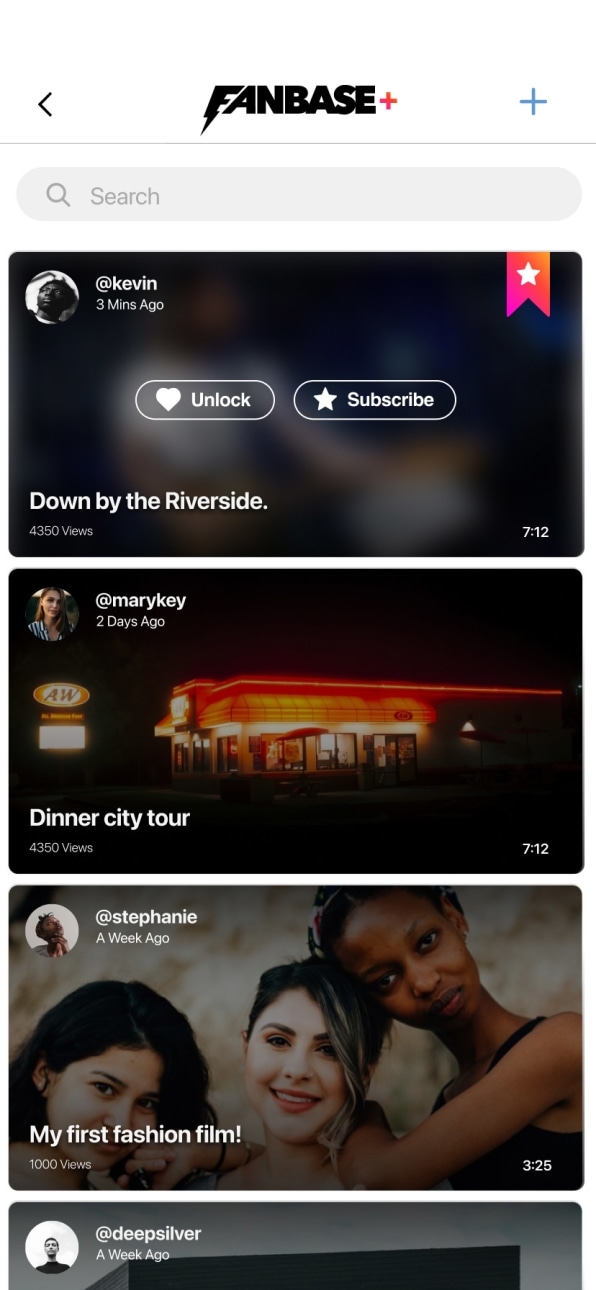
Those considerations don’t even take into account the inherent biases that creators of color encounter, resulting in a disconnect between users who create and users who profit. Racial pay disparities are well-known across industries, and that includes the influencer space. According to a 2021 study involving 400 U.S.-based creators, the pay gap between white influencers and influencers of color is 29%. When narrowed further between white and Black influencers specifically, the margin rises to 35%.
Like other apps, Fanbase lets users “like” other people’s content, but users can turn that attention into money through a digital tipping feature called Love. Every Love is worth one cent, half of which goes to the content creator each time someone “loves” their content. Fanbase takes a 50% cut from users’ revenue, which includes the 30% cut Apple takes; comparatively, the streaming platform Twitch takes a similar 50% from users while other revenue-generating platforms such as OnlyFans and Fanhouse take 20% and 10%, respectively. Among short-form video platforms, YouTube Shorts gets 55% of revenue, while TikTok allocates money from its Creator Fund, based on views—offering between 2 and 4 cents per view.
On Fanbase, the more Love a user gets, the more money they make. Beyond this direct monetization system, the app’s obvious strength lies in the various types of content it lets users create: photos, stories, livestreams, audio, short-form video, and Fanbase+—the platform’s long-form video tool, which supports videos as long as an hour. All of these formats can be monetized except for livestreams and Flickz, its short-video tool. With Flickz, the company has to navigate copyright on audios used in posts, but Hayes says the company is pushing to bring monetized livestreams to users; still, Flickz is trickier as the company has to navigate copyright on audio used.
“We have what Patreon has, we have what Clubhouse has, we have all these different verticals of what [other apps] have, except I’m looking out for every single person on the platform saying, this is how we want you guys to monetize,” Hayes says, adding that Fanbase’s onboarding process includes tool walkthroughs and explainers of features.
C.M. Williams, a full-time creator focused on tech, joined Fanbase in 2021. He admitted that, until January, he hadn’t put much effort into posting on Fanbase and instead focused on growing his presence on established platforms like Instagram and YouTube, where he has amassed 14,000 subscribers. But Williams has begun building his Fanbase following after being encouraged by other users on the app.
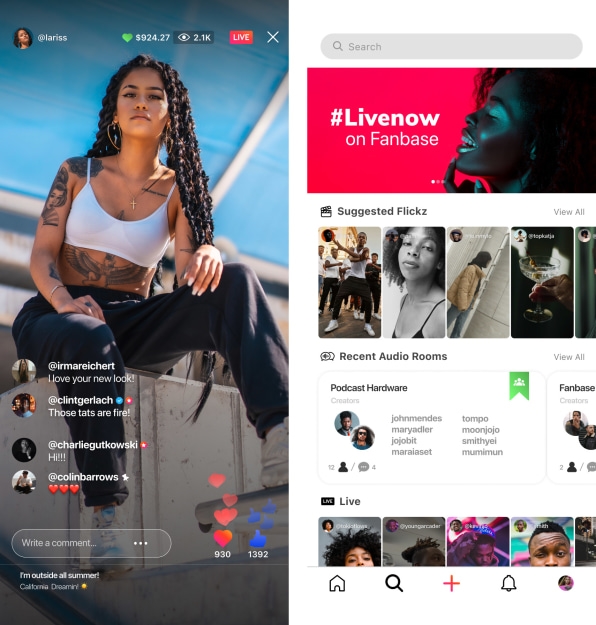
“It’s been a lot easier to make it a priority because this is an app you’re able to go to in real time and see how much money you’re making,” says Williams, who goes by the handle @techie.shooter on Fanbase. “When you have a money dopamine hit, you’re gonna start taking that app more seriously.”
That instant monetary gratification is undoubtedly appealing, but the genuine connections that Williams has formed on the app—which has a predominantly Black user base—is what attracts him to it the most. “I feel very close to the audience I have on there,” he says.
Some creators say a sense of community prevails on Fanbase, perhaps as a result of its crowdsourced funding. The app has secured a total of $10.7 million over three crowdfunding rounds since October 2020, which came from both small investors—users could contribute as little as $250 to earn equity—and celebrities, such as Snoop Dogg and Charlamagne tha God (Hayes put up $200,000 of his own money in the app’s early stages). Hayes had pivoted to crowdfunding capital after an early meeting with a VC firm left a sour impression—a common experience among Black entrepreneurs.
“I said, I can build anything that Facebook and Instagram can build, but Facebook and Instagram can’t build me,” Hayes recalls of the VC meeting. “I know that kids in Black culture power social media, so I don’t care how great the buttons are, how shiny the tech is, if you don’t have young people, primarily young people of color, creating culture, then your app doesn’t work.”
For Black creators, an app’s main draw goes beyond its physical functions. “As a Black content creator, we get a lot of shadow bans, and we get a lot of, like, just things that we aren’t allowed to promote,” says Tafari Young, who goes by @tafaritv on Fanbase and has partnered with the app as an informal ambassador at anime-related events. Young says that since he opened an account on Fanbase a year ago, he hasn’t encountered issues with shadow bans or content flagging.
Alyssa Castillo, who goes by @alyssacastillo1 on Fanbase, joined Fanbase after hearing Hayes talk about his new tech venture on the audio chatroom app, Clubhouse, in December 2021 (Fanbase’s own audio chat feature is one of its most used, according to Hayes). The fashion and lifestyle creator particularly likes the Fanbase+ feature, and believes that an app like Fanbase helps create an online space where Black creators can feel uplifted for their work.
“Certain content creators who look like me don’t get picked to do certain things [with brands or events], but they still want [our] input,” says Castillo, who was born and raised in Trinidad and Tobago, and promotes beauty brands on Instagram.
Hayes believes capitalizing on self-made content without an intermediary—brands and advertisers—will inevitably become the norm for everyone. In addition to tipping through Loves, users can opt for a paid subscription to a creator’s exclusive content, which costs $4.99 per month. The app is now beta-testing eight new paid subscription tiers, from $2.99 to as high as $99.99 per month.
A challenge Fanbase faces is expanding its audience. The app has roughly 400,000 users spread across the globe and has paid out over $811,000 to creators since its launch. Its comparatively smaller user base has made it hard for creators to build up a following even when they already have a sizable audience elsewhere (Fanbase has tried to smooth this transition with its migration tools to help users move their existing content from TikTok and Instagram onto Fanbase).
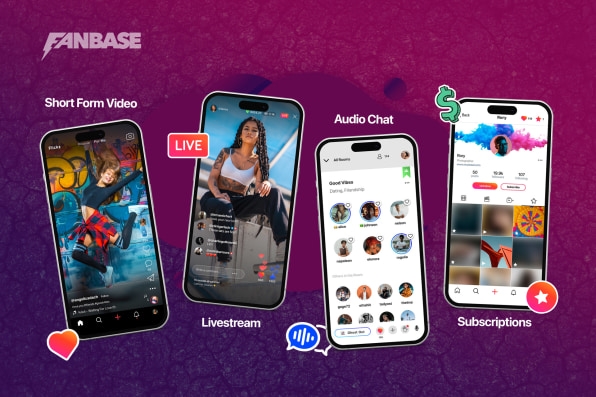
Castillo, whose Instagram has nearly 32,000 followers, has just 861 followers on Fanbase. She has made $96 total, with $32 coming from subscribers before she took down her paywall to attract more followers.
“I think [the subscriptions] probably would have worked if there could be more people on the platform,” says Castillo. “I don’t know how that would be resolved for me as a content creator to be pushed, so more people can see who I am.” Discoverability issues were a consistent feedback by some creators, though the platform seems to have begun resolving that issue through its updated explore page, which now features categorized content as well as separate sections for trending topics and top accounts to follow.
The app may still experience growing pains, but Fanbase’s direct monetization through its Love system and its strong sense of community, has attracted some ardent supporters. Williams, the tech creator, acknowledges Fanbase’s limited reach but believes in its future potential—so much so that he is among the small-time user-investors who contributed to the app’s crowdfunding.
“There’s gonna come a time where everything is going to basically be a paywall subscription model,” Williams says. “There’s not going to be this, ‘I’m posting my reel just to get the right eyes on it, we’ll see where it goes.’ It’s like, ‘No, if I posted a video, it’s probably making money.’”
(10)
Report Post